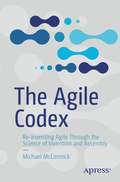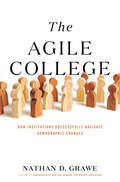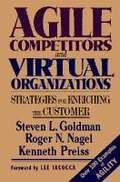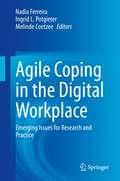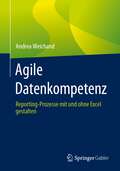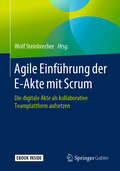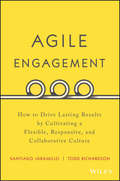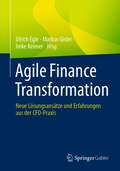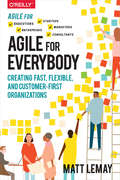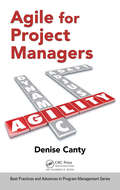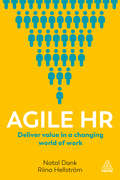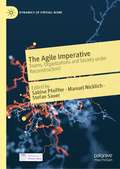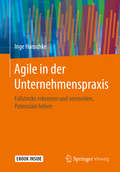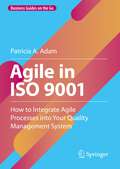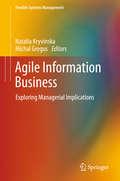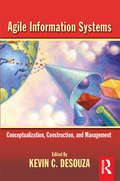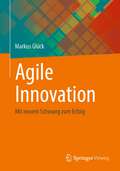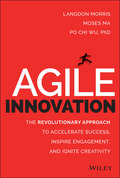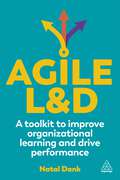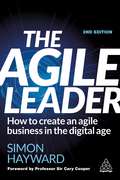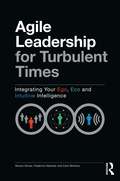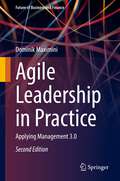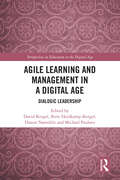- Table View
- List View
The Agile Codex: Re-inventing Agile Through the Science of Invention and Assembly
by Michael McCormickApply the industrial engineering science of invention and assembly to how software is described, planned, and built, allowing you to be free to flex your practices according to your needs, putting principle over habit and rules.Reading about Agile practices is like reading diet advice. Everything sounds unique and good; everything starts with good intentions. Then reality sets in. Organizations adapt their practices, but lose sight of grounding principles. A bias toward ceremonies, metrics, and recipes comes at the expense of efficiently getting the real work done. Managers and developers are incentivized to game the system. Organizational metrics become detached from the reality of what is being delivered and how.The Agile Codex shows you how to describe a software project as an acyclic dependency tree of sized work items, scoped to be operated on by one software engineer each and completed within a week. It provides Open Source tooling to help you visualize, sequence and assign these work items to account for risk and increase predictability in your delivery times. You’ll see the value of doing this as it applies to efficiently planning and adjusting software projects in the face of learning and change. Finally, the book covers the collaborative agile principles required to bring this skill set and practice to a software team.Throughout the book you’ll be reminded that software engineering is not a rote task - it is primarily a skilled, creative act. As such, you’ll see that we need to account for the space needed to research, plan, create, and adjust. The Agile practices serving the codex deal with this intersection between the engineering problem of software delivery flow, and the human reality of how work is described, owned, executed, and transitioned from one state to another.Everything an agile team does must serve the codex. The creation and the care and feeding of this structured tree of work sets the frame in which all other team actions take place and against which all successes or failures can be evaluated.
The Agile College: How Institutions Successfully Navigate Demographic Changes
by Nathan D. GraweFollowing Grawe's seminal first book, this volume answers the question: How can a college or university prepare for forecasted demographic disruptions?Demographic changes promise to reshape the market for higher education in the next 15 years. Colleges are already grappling with the consequences of declining family size due to low birth rates brought on by the Great Recession, as well as the continuing shift toward minority student populations. Each institution faces a distinct market context with unique organizational strengths; no one-size-fits-all answer could suffice.In this essential follow-up to Demographics and the Demand for Higher Education, Nathan D. Grawe explores how proactive institutions are preparing for the resulting challenges that lie ahead. While it isn't possible to reverse the demographic tide, most institutions, he argues persuasively, can mitigate the effects. Drawing on interviews with higher education leaders, Grawe explores successful avenues of response, including • recruitment initiatives• retention programs• revisions to the academic and cocurricular program• institutional growth plans• retrenchment efforts• collaborative actionThroughout, Grawe presents readers with examples taken from a range of institutions—small and large, public and private, two-year and four-year, selective and open-access. While an effective response to demographic change must reflect the individual campus context, the cases Grawe analyzes will prompt conversations about the best paths forward. The Agile College also extends projections for higher education demand. Using data from the High School Longitudinal Study, the book updates prior work by incorporating new information on college-going after the Great Recession and pushes forecasts into the mid-2030s. What's more, the analysis expands to examine additional aspects of the higher education market, such as dual enrollment, transfer students, and the role of immigration in college demand.
Agile Competitors and Virtual Organizations: Strategies for Enriching the Customer
by Steven L. Goldman Roger N. Nagel Kenneth PreissIdentifying the "new industrial revolution," the authors present a vision for "cooperating to compete" in today's rapidly-changing business world. Nagel, Goldman, and Preiss show exactly why mass production is a thing of the past, and why customized products are the key to business survival.
Agile Consumer Product Innovation with Alibaba's Tmall Innovation Center
by Daniel O'Connor James Palano William R. KerrCase
Agile Coping in the Digital Workplace: Emerging Issues for Research and Practice
by Melinde Coetzee Ingrid L. Potgieter Nadia FerreiraThis volume outlines emerging issues for research and practice related to agile coping dynamics in the digital era. Chapters in this book report on current research on the key constructs and processes underlying coping dynamics in multi-disciplinary domains and across the life-span. Chapters compare current research trends in terms of future potential directions for research on coping dynamics in the digital era. The book also critically evaluates the relevance, applicability and utility of the research findings and theoretical premises in various classical, current and potential emerging issues for research and practice in the smart digital technological world of work for employee across their careers.Among the topics discussed:The digital era: contextual issues and copingIssues for organizational practiceIssues for individualsCoping within the employability contextAgile Coping in the Digital Era provides theoretical premises and research perspectives, while also evaluating the practical utility of theory and research ideas for management and employee practices in Industry 4.0 organizational contexts.
Agile Datenkompetenz: Reporting-Prozesse mit und ohne Excel gestalten
by Andrea WeichandIn diesem Buch hinterfragt Andrea Weichand die bestehenden Reporting-Routinen. Die manuelle Arbeit im bekannten Tabellenkalkulationsprogramm Excel hat sich nicht nur etabliert, sie nimmt auch weiterhin zu. Dies ist ein großes Problem für die Innovations- und Zukunftsfähigkeit so mancher Controlling-, Sales-, oder Marketingabteilungen. Wie datenkompetent ist ein Unternehmen, wenn ein Großteil der Datenarbeit in Excel zurechtgeschustert wird? Wie schafft man es im Berufsalltag, Daten effizient und mit hoher Qualität in passende Datenprodukte zu bringen? Welche Rolle spielt die Pivot-Tabelle? Weichand beschreibt einen neuen Weg zu mehr Datenkompetenz und erklärt, warum die Prinzipien Kreativität, Strategie und Agilität so wertvoll dabei sind. Ihr Ziel ist es, all die Angestellten, die sich Tag für Tag mit ihren anstrengenden und monströsen Excel-Dateien quälen, zu ermutigen,die Datenprozesse (mit und ohne Excel) zu automatisieren,die eigene Datenkompetenz weiterzuentwickeln undeine kreative, zukunftsfähige Perspektive für agile Datenarbeit einzunehmen.
Agile Einführung der E-Akte mit Scrum: Die digitale Akte als kollaborative Teamplattform aufsetzen
by Wolf SteinbrecherDieses Buch nimmt Ihnen Ihre Unsicherheit bei der Einführung der E-Akte Die Digitalisierung macht auch vor der Dokumentenverwaltung in Behörden oder größeren Organisationen nicht Halt. Um in diesem Bereich vorherrschende Unsicherheiten abzubauen und die Aktenführung im Sinne der Verwaltung 4.0 im Zeitalter der Digitalisierung voranzutreiben, hat Wolf Steinbrecher dieses Buch über die Einführung der E-Akte (elektronische Akte) herausgegeben. Es begleitet Sie bei jeder Phase eines solchen Projekts und stellt agile Vorgehensweisen detailliert dar:Vision der E-Akte und digitaler mehrdimensionaler AktenplänenVorstellung eines Musterlastenhefts und eines agilen Vertrags nach EVB-ITGestaltung von Abteilungsworkshops beim Roll-outLesen Sie in diesem Buch außerdem nach, wie Sie Ihre Mitarbeiter vom Nutzen der Einführung von E-Akten überzeugen und sie in die aktive Mitgestaltung einer neuen Arbeitsumgebung miteinbeziehen. Denn nur so sind Sie in der Lage, die Digitalisierung in der (öffentlichen) Verwaltung im Sinne des papierlosen Büros zu einem Erfolgsprojekt zu machen. Zukunftsweisende Impulse für jede ProjektphaseDieses Buch untergliedert die Einführung der E-Akte in drei Teile. Erfahren Sie zunächst, wie Sie Ihre Vision des Arbeitens mit digitalen Akten richtig formulieren. Anschließend zeigen Ihnen die Verfasser einen idealen Projektverlauf auf, bevor die Implementierung neuer Prozesse im Vordergrund steht. Daneben befasst sich dieses Werk auch mit diesen Schwerpunkten: Problem: SchnittstellenKick-off in einer AbteilungEinen Prozess ins DMS überführenBieterpräsentationen vorbereitenPraktische Tipps, beispielsweise mit Blick auf die DMS (Dokumentenmanagement-Software) -Beschaffung, sowie Erfahrungsberichte verschiedener Stakeholder runden dieses Buch über die Einführung von E-Akten ab. Daher ist dieses Sammelwerk mit Blick auf die digitale Transformation im eGovernment-Bereich eine Empfehlung für:Führungskräfte, die in ihrer Abteilung die E-Akte mittels DMS einführen möchtenLeiter einer Organisations- oder IuK (Informations- und Kommunikationstechnik) -AbteilungMitarbeiter in der Datenverarbeitung
Agile Engagement: How to Drive Lasting Results by Cultivating a Flexible, Responsive, and Collaborative Culture
by Santiago Jaramillo Todd RichardsonAchieve unprecedented business value by fostering true employee engagement Many organizations fail to realize and harness the power of their most valuable asset--their employees. Though they can be developed into a true competitive advantage, engagement isn't attainable if the employee isn't invested in the company's overall success. Agile Engagement offers business leaders a concrete strategy for building, maintaining, and utilizing employee engagement to achieve the highest level of business success. The key? Employees must feel like they are a part of their company's culture instead of having it handed down to them. Stories of failed employee engagement initiatives abound, and they all have one thing in common: they begin from the premise of "initiative" rather than "employee." True engagement occurs when an employee's heart and mind are activated in a way that leads to their motivation and commitment to positively impact the company's goals and vision. This book shows you how to create an environment that stresses a culture of unity at all levels by showing you how to: Create a clear, compelling vision and corresponding engagement strategy through the Engagement Canvas Communicate your unique culture strategy throughout all levels of your company Foster grassroots, employee-led engagement initiatives Improve engagement continuously with the Emplify Score tool Agile Engagement provides a deeper look into real engagement, helping you foster a work environment that's rewarded with unsurpassed productivity, innovation, and competitive advantage, as well as employees who feel valued, respected, and heard.
Agile Finance Transformation: Neue Lösungsansätze und Erfahrungen aus der CFO-Praxis
by Ulrich Egle Markus Gisler Imke KeimerAgilität und Finanzen – was sich zunächst nach einem Paradoxon anhört, ebnet in der heutigen Zeit sowohl das richtige Mindset als auch die Methoden, um den Herausforderungen der VUCA-Welt zu begegnen. Wie kann eine Finanzorganisation schnell und flexibel reagieren und dabei den Wertbeitrag erhöhen? Die Antwort liegt in der agilen Transformation der Finanzfunktion. Dieser Herausgeberband liefert nicht nur die theoretischen Grundlagen zur Agile Finance Transformation, sondern neben Experteninterviews, fundierte Lösungsansätze und Best-Practice-Beispiele."Mit dem Thema Agilität und Finanzfunktion im Kontext der Transformation und Digitalisierung haben die Herausgeber ein vielschichtiges und in manchen Aspekten durchaus auch kontroverses Thema aufgegriffen, das jeden Finanzverantwortlichen betrifft."Dr. Raymund Scheffrahn, Group CFO der Variosystems Gruppe & Vorstandsmitglied des CFO Forums Schweiz.
Agile for Everybody: Creating Fast, Flexible, and Customer-First Organizations
by Matt LeMayThe Agile movement provides real, actionable answers to the question that keeps many company leaders awake at night: How do we stay successful in a fast-changing and unpredictable world? Agile has already transformed how modern companies build and deliver software. This practical book demonstrates how entire organizations—from product managers and engineers to marketers and executives—can put Agile to work.Author Matt LeMay explains Agile in clear, jargon-free terms and provides concrete and actionable steps to help any team put its values and principles into practice. Examples from a wide variety of organizations, including small nonprofits and global financial enterprises, bring to life the on-the-ground realities of Agile across industries and functions.Understand exactly what Agile is and why it mattersUse Agile to address your organization’s specific needs and goalsTake customer centricity from theory into practiceStop wasting time in "report and critique" meetings and start making better decisionsCreate a harmonious cycle of learning, collaborating, and deliveringLearn from Agile experts at companies like IBM, Spotify, and Coca-Cola
Agile for Project Managers (Best Practices In Portfolio, Program, And Project Management Ser.)
by Denise CantyAgile project management is a proven approach for designing and delivering software with improved value to customers. Agility is all about self-directed teams, feedback, light documentation, and working software with shorter development cycles.The role of the project manager with agile differs significantly from traditional project management in th
Agile HR: Deliver Value in a Changing World of Work
by Natal Dank Riina HellströmIn the new world of work, agility is a business imperative. From small tech start-ups or large traditional companies, organizations need to be fast, flexible and digitally empowered to succeed. However, too many companies are stuck with siloed, compliance-driven HR processes that work in opposition to the business rather than supporting it. This results in the view that HR is slow and out of touch. However, Agile HR shows that this doesn't need to be the case. It is a practical guide written specifically for people professionals on how the HR function can develop agile processes and practices that save time, boost performance and support overall business goals. Covering every aspect of the HR function from people processes, ways of working and HR services to organization design, operating models and HR teams, Agile HR is an essential guide for all HR practitioners wanting to make their HR practices agile and drive business performance but don't know where to start. As well as guidance on how to deal with resistance, manage a backlog and deal with constraints, there is also invaluable guidance on how HR can prioritize effectively and assess which activities to pursue, which to develop, which to rework and which to abandon in order to achieve continuous business improvement. Supported by case studies from organizations who have seen the benefits of an agile approach to HR including Sky Betting & Gaming and MUJI, this is critical reading for all HR professionals in organizations of any size needing to adopt fast, flexible and evolving agile approaches to effectively compete in the new world of work.
The Agile Imperative: Teams, Organizations and Society under Reconstruction? (Dynamics of Virtual Work)
by Sabine Pfeiffer Manuel Nicklich Stefan SauerIn an ever-changing working environment, customer and workplace demands have brought new challenges to how we organize and manage work. Increasingly, this is addressed by the idea of 'agility.' From its beginning, agile work has claimed to be a radically different approach which allows organisations to react flexibly to changing environmental demands whilst also offering a ‘people' centered approach to management.While the literature often examines agile instruments from a business perspective, this edited collection advances the discussion of the efficacy of agile working, by applying a more critical social science perspective.The chapters scrutinize whether agility is just a discursive imperative, or whether it is in fact a genuine organizational and institutional strategy that is meant to better deal with complexity and volatility. The answers to these questions can vary at different levels, and the editors therefore examine agility at the level of teams, organizations and societies. By assembling different perspectives on the sustainability and virtue of agile instruments, and by bringing together international scholars from a variety of disciplines, the project stimulates a comparative discussion.
Agile in der Unternehmenspraxis: Fallstricke erkennen und vermeiden, Potenziale heben
by Inge HanschkeDas Praxisbuch bietet eine pr#65533;gnante Einf#65533;hrung zum Thema agile Methoden und Techniken wie z. B. Scrum und Kanban sowie Continuous Delivery und DevOps. Weitere Schwerpunktthemen sind u. a. Agilit#65533;t in hierarchisch gepr#65533;gten oder ,,formalen" Unternehmen erfolgreich einf#65533;hren und betreiben sowie agile Planungen im Vorfeld und innerhalb von Projekten. Die Autorin gibt zahlreiche Tipps und Tricks sowie unmittelbar anwendbare Leitf#65533;den und Empfehlungen an die Hand.
Agile in ISO 9001: How to Integrate Agile Processes into Your Quality Management System (Business Guides on the Go)
by Patricia A. AdamDo you ask yourself what this ‘agility hype’ is actually about and in what cases agility really creates benefits? Would you like to know how to make processes more agile? Do you fancy the idea of using agile methods but don't know how to explain it to your ISO 9001 auditor?This is the book you’ve been waiting for!Written from a quality management professional’s point of view, it offers useful solutions and practical advice concerning the use of agile practices in ISO 9001-based quality management systems. Agility for organisations is defined and described in a structured way. It is shown in detail how agile practices can be integrated into a QM system while maintaining the ISO 9001 certification. You will find out what needs to be considered when systemically incorporating agile practices, and how to balance the benefits and limitations of agility in organisations. Based on a qualitative, intersectoral research initiative, this book provides unique, state-of-the-art information and valid arguments for focused organisational development. It is intended for professionals such as quality managers, innovation managers, auditors of ISO management standards, organisational developers and managers who lead ISO 9001-certified companies.
Agile Information Business: Exploring Managerial Implications (Flexible Systems Management)
by Natalia Kryvinska Michal GregusThis book accomplishes an analysis of critical aspects of managerial implications on the business with information. The business dealing with information is spreading in the service market; and, an efficient management of informational processes, in order to perform successful business with them, is now crucial. Besides, economical/business, technological or any other kind of information, organized in a variety of forms, can be considered as an 'informational product'. Thus, creating a business value out of information is challenging but vital, especially in the modern digital age. Accordingly, the book covers the methods and technologies to capture, integrate, analyze, mine, interpret and visualize information out of distributed data, which in turn can help to manage information competently. This volume explores the challenges being faced and opportunities to look out for in this research area, while discussing different aspects of this subject. The book will be of interest to those working in or are interested in joining interdisciplinary and transdisciplinary work in the areas of information management, service management, and service business. It will also be of use to young generation researchers by giving them an overview on different aspects of doing business with information. While introducing them to both technical and non-technical details, as well as economic aspects, the book will also be extremely informative for professionals who want to understand and realize the potential of using the cutting-edge managerial technologies for doing successful business with information/ services.
Agile Information Systems
by Kevin DesouzaThis book presents cutting-edge research and thinking on agile information systems. The concept of agile information systems has gained strength over the last 3 years, coming into the MIS world from manufacturing, where agile manufacturing systems has been an important concept for several years now. The idea of agility is powerful: with competition so fierce today and the speed of business so fast, a company’s ability to move with their customers and support constant changing business needs is more important than ever. Agile information systems:• have the ability to add, remove, modify, or extend functionalities with minimal penalties in terms of time, cost, and effort • have the ability to process information in a flexible manner • have the ability to accommodate and adjust to the changing needs of the end-users.This is the first book to bring together academic experts, researchers, and practitioners to discuss how companies can create and deploy agile information systems. Contributors are well-regarded academics known to be on the cutting-edge of their fields.The Editor, Kevin Desouza, has organized the chapters under three categories: • discussion of the concept of agile information systems (i.e. defining agile information management, its attributes, antecedents, consequences, etc.)• discussion of information systems within the context of agility (i.e., descriptions of agile information systems and their attributes, how to build agile information systems, etc.)• discussion of organizational management issues in the context of agile information systems (i.e., how to prepare the organization for agile information systems, management of agile information systems for improved organizational performance, etc.)
Agile Innovation: Mit neuem Schwung zum Erfolg
by Markus GlückInnovationen sind für Unternehmen lebensnotwendig. Dies gilt in sich mit hohem Tempo revolutionär verändernden Märkten für Startups wie für Bestandsfirmen. Allerdings fehlt beiden heute oft die nötige Wirksamkeit der Innovationsanstrengungen, weil der Reifegrad der Ausführung oder das Geschäftsmodell Kunden nicht wirklich begeistert. Oder weil das nötige Umsetzungstempo lahmt. Dabei sind viele Faktoren und vor allem die von den Führenden geprägten kulturellen Rahmenbedingungen erfolgsentscheidend. Doch Agilität und Startup-Mentalität - häufig zitiert - sind nicht automatisch ein Allheilmittel für nachhaltigen Innovationserfolg.Dieses Buch greift wesentliche Prinzipien agilen Managements auf, adressiert Schwachstellen in der klassischen Innovationspraxis und löst synergetisch das sich ergebende Spannungsfeld von Prozessorientierung und Wandlungsfähigkeit auf. Es sorgt als praxisorientierter Leitfaden mit Orientierungshilfen für nachhaltigen Innovationserfolg und Disruption im Unternehmensalltag.
Agile Innovation: The Revolutionary Approach to Accelerate Success, Inspire Engagement, and Ignite Creativity
by Langdon Morris Po Chi Wu Moses MaFind your company's unique innovation style, and nurture it into a powerful competitive advantage Praised by business leaders worldwide, Agile Innovation is the authoritative guide to survival and success in today's "innovate-or-die" business world. This revolutionary approach combines the best of Agile with the world's leading methods of Innovation to present a crisp, articulate, and proven system for developing the breakthrough capabilities every organization must master to thrive today and tomorrow. You already know that effective innovation doesn't happen by accident—it is achieved by careful design. Agile Innovation addresses the three critical drivers of innovation success: accelerating the innovation process; reducing the risks inherent in innovation; and engaging your entire organization and your broader ecosystem in the innovation effort. The key frameworks described here build on the proven success of Agile to provide a comprehensive and customizable Innovation Master Plan approach to sustained innovation improvement in the five critical performance areas: strategy, portfolio, process, culture and infrastructure. Major topics include: the power of Agile in the innovation process, how to overcome innovation risk, the best tools to evoke engagement and collaboration, branding as an integral element of innovation, and the best leadership skills and practices that create the special environment that enables transformative growth. Readers will learn specifically how to create better ideas, develop them more efficiently, and work together more profitably and effectively to achieve breakthroughs. The insights offered in this book are highlighted in 11 detailed case studies illustrating the world's best innovation practices at Wells Fargo, Nike, Volvo, Netflix, Southwest Airlines, NASA,The New York Times, and others, in dozens of specific business examples, in two dozen powerful and unique techniques and methods, and a full set of implementation guidelines to put these insights into practice. Key Insights: Understand how to implement the many ways that innovation efforts can be accelerated to achieve even greater competitive advantage Learn to create a culture of innovation, greater engagement, and rich collaboration throughout your organization Discover how to reduce risk and accelerate learning Implement your own unique plan to enhance collaborative innovation, from leadership through operations Integrate key agility principles into your strategic planning decisions for sustained improvement Explore dramatic new approaches to open innovation that optimize large scale innovation Apply the latest and best technology tools to enhance innovation, reduce risk, and promote broad participation. This is a must read book, a practical guide for fostering a culture of innovation, nurturing creativity, and efficiently developing the ideas that drive strategic growth. And since innovation is not imitation, you know that copying the ideas and strategies of other successful organizations will not produce the desired outcomes. Hence, all leaders must develop their own way of innovating and nurture the right style of collaborating for their own organization. This book will guide you to find your own unique pathways to success. Blaze your own trail to the high levels of innovativeness and organizational agility by learning from the expert guidance and practical, actionable advice offered throughout this important book.
Agile L&D: A Toolkit to Improve Organizational Learning and Drive Performance
by Natal DankAgility is no longer a buzzword, it's now a business imperative. Apply agile thinking, tools and processes to the learning function with this expert guide written specifically for learning and organizational development (OD) professionals.Written by an author at the forefront of agility in the people profession, Agile L&D explains how to develop an agile approach to workplace learning. The business context has dramatically changed, so the way you approach specialisms like learning and OD must also change.Based on five design principles: Product-led, Human-centric design, T-shaped people in T-shaped teams, Experimentation and Deliver with impact, Agile L&D provides a dedicated toolkit to help you design learning and OD solutions that solve workplace challenges and impact business performance. How we design work, upskill people and deploy teams is now intrinsically linked with modern business strategy. To continuously adapt to a complex business environment, companies need a more fluid movement of people and skills across the organization to better reflect customer needs, market opportunities and capability requirements. This book has the answer. Full of tools, tips and frameworks as well as real world examples from global organizations including Macmillan Cancer Support, TomTom, Diageo, Arup and Citizens Advice, this is essential reading for all learning and development, OD and people professionals in this constantly changing world of work.
The Agile Leader: How to Create an Agile Business in the Digital Age
by Simon HaywardThe Agile Leader exposes how leaders can safely guide their teams to organizational stability and prosperity through agile leadership and building an agile culture. With the rise of political unrest, protectionism and economic uncertainties, business leaders have to assess, react and implement strategies rapidly and with enough responsiveness to re-calibrate their efforts should circumstance change. When presented with key moments of choice, agility allows them to move quickly and responsively, and offer coping strategies for this unprecedented rate of change. By adopting agile ways of working that focus on facilitating mental agility, ruthlessly prioritizing, devolving decision-making, and investing in customer research, leaders will allow organizational learning and drive innovation, thus enabling their teams to flourish in this new uncertain world. With globally diverse and exciting case studies from top businesses including the British Fashion Council, Standard Chartered and Three, Dr Simon Hayward distills years of leadership research and consultancy work into an actionable agile leadership programme, which will deliver effective results for your business. The Agile Leader is an invaluable book for leaders looking to adapt and continuously evolve to match a complex business world.
The Agile Leader: How to Create an Agile Business in the Digital Age
by Simon HaywardEver feel like you and your team are stretched across multiple demands or that the goal posts change constantly? Never before have businesses felt so acutely this constant need to adapt, pivot and change tack. This book will teach you how you can not only survive in the context of digital transformation, but also thrive and grow, by adopting a powerful agile leadership model. This new and revised edition of The Agile Leader lays out clearly in eight steps how agile leaders empower their team to make decision quickly, evaluate correctly where the biggest opportunities are and mould their strategies around market dynamics and ever-changing needs. If there's one leadership skill that successful businesses have in spades, it's the ability to enable teams to adapt and grow within complex eco-systems of clients, partners and suppliers. By focusing on teamwork and collaboration, as well as promoting shared decision making and ruthless prioritizing, leaders can transform the way they work as well as how their teams function to make them more malleable. Simon Hayward is an agile leadership expert. In this new edition of this successful book, he distills years of leadership and agile research into an actionable 8 step plan, brought to life with examples of agile digital businesses. Learn how to become agile and make digital transformation and delivery part of your business as usual.
Agile Leadership for Turbulent Times: Integrating Your Ego, Eco and Intuitive Intelligence
by Sharon Olivier Frederick Hölscher Colin WilliamsThis thought-provoking and engaging book is for you, whatever your seniority, in the private or public sector – if you are curious about the role and purpose of leadership in a turbulent world. It will help you become a more agile leader through understanding and integrating your ego, eco and intuitive intelligence. You will gain a deeper understanding of your unique leadership blend through a short diagnostic inventory, bringing insight about your strengths and what may be tripping you up. The book offers tips, ideas and practical suggestions on how to develop your ability to use the three intelligences in order to expand your leadership repertoire. It will help you enable the teams you lead to be more flexible, responsive and autonomous. The authors have drawn on their vast experience from the boardroom to the shop floor, the classroom and research around the world, to write an easy-to-digest yet ground-breaking book that deals with the root causes of today’s twenty-first-century leadership challenges. Its contents are straightforward and widely applicable.
Agile Leadership in Practice: Applying Management 3.0 (Future of Business and Finance)
by Dominik MaximiniThis book illustrates the agile transformation journey of a consulting organization. It consists of nine main chapters, each focusing on specific aspects of transformation. These include establishing value in business, holistic recruitment and retention, innovating performance appraisals, rethinking organizational structure, redesigning leadership roles, streamlining measurement and reward systems, and improving career paths. Some specific processes, such as corporate decision making, SMILE (budget for business improvement at employee discretion), project selection, holiday leave, and career coaching are also described. All of the transformations described build up on Management 3.0, a collection of management principles and practices that fit perfectly in an agile world.The book is of practical relevance for managers and agile coaches who want to learn how to approach agile transformation.
Agile Learning and Management in a Digital Age: Dialogic Leadership (Perspectives on Education in the Digital Age)
by David Kergel Birte Heidkamp-Kergel Hanne Nørreklit Michael PaulsenThis book offers a detailed theoretical analysis of the fields of learning and management in the digital age. Taking an interdisciplinary approach, it opens a dialogue between agile management theory and agile learning theory. The book argues that there is a tension between participative and action-orientated approaches on the one hand and neoliberal enclosure of the actor on the other hand. It takes this as an opportunity for interdisciplinary dialogue between learning theories and management concepts. With contributions from a range of international experts, chapters discuss the need for suitable theoretical, epistemological, and ethical foundations as well as practice-orientated methods for learning and management to implement appropriate strategies and meet educational challenges. This highly topical book will be of great interest to academics, postgraduate students, and researchers in the fields of digital learning, educational theory, management theory, and communication studies.
